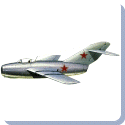 Mikoyan-Gurevich MiG-15 — The Mikoyan-Gurevich MiG-15 was a jet fighter developed for the USSR by Artem Mikoyan and Mikhail Gurevich. The MiG-15 was one of the first successful swept wing jet fighters, and it achieved fame in the skies over Korea, where early in the war, it outclassed all straight-winged enemy fighters in daylight. The MiG-15 also served as the starting point for development of the more advanced MiG-17 which was still an effective threat to supersonic American fighters over North Vietnam in the 1960s. The MiG-15 is believed to have been the most widely produced jet aircraft ever made, with over 12,000 built. Licensed foreign production perhaps raised the total to over 18,000. The MiG-15 is often mentioned along with the North American F-86 Sabre in lists of the best fighter aircraft of the Korean War and in comparison with fighters of other eras.
Mikoyan-Gurevich MiG-15 — The Mikoyan-Gurevich MiG-15 was a jet fighter developed for the USSR by Artem Mikoyan and Mikhail Gurevich. The MiG-15 was one of the first successful swept wing jet fighters, and it achieved fame in the skies over Korea, where early in the war, it outclassed all straight-winged enemy fighters in daylight. The MiG-15 also served as the starting point for development of the more advanced MiG-17 which was still an effective threat to supersonic American fighters over North Vietnam in the 1960s. The MiG-15 is believed to have been the most widely produced jet aircraft ever made, with over 12,000 built. Licensed foreign production perhaps raised the total to over 18,000. The MiG-15 is often mentioned along with the North American F-86 Sabre in lists of the best fighter aircraft of the Korean War and in comparison with fighters of other eras.
NATO and USAF reporting names were as follows:
- MiG-15 — NATO reporting name “Fagot”, USAF/DoD reporting name “Type 14”.
- MiG-15P — NATO reporting name “Fagot”, USAF/DoD reporting name “Type 19”.
- MiG-15UTI — NATO reporting name “Midget” USAF/DoD reporting name “Type 29”.
Design and Development
Most early jets were designed like piston engined fighters with straight wings, limiting their high speed performance. German research during World War II had shown that swept wings would perform better at transonic speeds, and Soviet aircraft designers were quick to take advantage of this information. Claims that the successful Soviet piston-engined fighter designers Artem Mikoyan and Mikhail Gurevich (the lead designers of the “MiG” bureau) were heavily influenced by the Focke-Wulf Ta 183, however, have been discredited. Although the abortive late-war German jet had swept wings and bore a superficial resemblance to the later MiG-15, the two aircraft are very different in structure and general design. The Soviets did seize plans and prototypes for the Ta-183, but the majority of Focke-Wulf engineers were captured by Western armies. Currently, most sources acknowledge that the MiG-15 is an original design that benefited from German research, but was conceived, designed,engineered and produced by the Soviets.
By 1946, Soviet designers were finding it impossible to perfect the German-designed HeS-011 axial-flow jet engine, and new airframe designs from Mikoyan were threatening to outstrip development of the jet engines needed to power them. Soviet aviation minister Mikhail Khrunichev and aircraft designer Alexander Sergeyevich Yakovlev suggested to Joseph Stalin that the USSR buy advanced jet engines from the British. Stalin is said to have replied: “What fool will sell us his secrets?” However, he gave his assent to the proposal and Artem Mikoyan, engine designer Vladimir Klimov, and others traveled to the United Kingdom to request the engines. To Stalin’s amazement, the British Labour government and its pro-Soviet Minister of Trade, Sir Stafford Cripps, were perfectly willing to provide technical information and a license to manufacture the Rolls-Royce Nene centrifugal-flow jet engine, a move which even Russian sources have mocked. This engine was reverse-engineered and produced as the Soviet Klimov RD-45 jet engine, subsequently incorporated into the MiG-15. (Rolls-Royce later attempted to claim £207 million in license fees, but without success.)
In the interim, on 15 April 1947, the Council of Ministers issued decree #493-192, which ordered the Mikoyan OKB to build two prototypes for a new jet fighter. As the decree called for a first flight as soon as December of that same year, the designers at OKB-155 fell back on an earlier troublesome design, the MiG-9. The MiG-9 suffered from an unreliable engine and control problems; the first would be solved by the excellent new Klimov engine, and to solve the second, the designers began experimenting with swept wings and also redesigned the tail unit. The resulting prototypes were designated I-310.
The I-310 was a clean, swept-wing fighter with wings and tail swept at a 35° angle. The I-310 had exceptional performance, with a top speed of over 650 mph (1,040 km/h). The I-310’s primary competitor was the similar Lavochkin La-168. After evaluations, the MiG design was chosen for production. Designated MiG-15, the first production example flew on 31 December 1948. It entered Soviet Air Force service in 1949, and would subsequently receive the NATO reporting name “Fagot.” Early production examples had a tendency to roll to the left or right due to manufacturing variances, and so aerodynamic trimmers called “nozhi (knives)” were fitted to correct the problem, the knives being adjusted by ground crews until the aircraft flew correctly.
An improved variant, the MiG-15bis (“bis” being Latin for “second”), entered service in early 1950 with a Klimov VK-1 engine, an improved version of the RD-45/Nene, plus minor improvements and upgrades. (Visible differences are: a headlight in air intake separator and horizontal upper edge of air brakes in MiG-15).The MiG-15 arguably had sufficient power to dive at supersonic speeds, but could not do so because it did not feature an “all-flying” tail. As a result, the pilot’s ability to control the aircraft deteriorated significantly as Mach 1 was approached. Later MiGs would incorporate all-flying tails.
The MiG-15 was originally intended to intercept American bombers like the B-29, and was even evaluated in mock air-to-air combat trials with interned ex-US B-29 bombers as well as the later Soviet B-29 copy, the Tupolev Tu-4. To ensure the destruction of such large bombers, the MiG-15 carried heavy cannon armament: two 23 mm cannon with 80 rounds per gun and a single massive 37 mm cannon with 40 rounds. These weapons provided tremendous punch in the interceptor role, but their limited rate of fire and relatively low velocity made it more difficult to score hits against small and maneuverable enemy jet fighter aircraft in air-to-air combat. The 23 mm and 37 mm cannon also had radically different ballistic characteristics, and some United Nations pilots during the Korean War had the unnerving experience of having 23 mm shells pass over them while the 37 mm shells flew under them. The cannon were fitted into a neat pack that could be winched down out of the bottom of the nose for servicing and reloading, in principle allowing a preprepared pack to be switched in for rapid turnaround. (Some sources claim the pack was added in later MiG-15 production but it was fitted from the outset.)
A variety of MiG-15 variants were built, but the most common was the MiG-15UTI (NATO reporting name Midget) two-seat trainer. Because Mikoyan-Gurevich never mass-produced the transition training versions of the later MiG-17 or MiG-19, the MiG-15UTI remained the sole Warsaw Pact advanced jet trainer well into the 1970s, the primary training role being fulfilled exclusively by Czechoslovak Aero L-29 Delfin and the L-39 Albatros jet trainers (save for Poland, which used their indigenous TS-11 Iskra jets). While China produced two-seat trainer versions of the later MiG-17 and MiG-19, the Soviets felt that the MiG-15UTI was sufficient for their needs and did not produce their own trainer versions of those aircraft.
History
US Air Force MiG-15 delivered by a defecting North Korean pilot. The MiG-15 was widely exported, with the People’s Republic of China receiving MiG-15bis models in 1950. Chinese MiG-15s took part in the first jet-versus-jet dogfights after communist North Korea’s invasion of South Korea. The swept-wing MiG-15 quickly proved superior to the first-generation, straight-wing jets of the United Nations air forces, such as the F-80 and Gloster Meteor, as well as piston-engined F-51 Mustangs and F4U Corsairs (although an American F-80 would score the first all-jet, air-to-air kill in history over a MiG-15). Only the F-86 Sabre with its highly trained crews would be able to consistently defeat it in air combat.
The F-86 was America’s first swept-wing fighter and was introduced in December 1950. It essentially added new wings to the US Navy’s FJ-1 Fury. Although the Sabre could not match the MiG-15 in some performance areas, superior tactics and pilot training allowed Sabre pilots to achieve high kill ratios against Chinese and North Korean pilots, while supposedly not being as successful against the better trained and experienced Soviet pilots. Eager to obtain an intact MiG for testing, the United States offered a reward of US$100,000 and political asylum to any pilot who would defect with his airplane. Eventually a North Korean pilot, Lieutenant No Kum-Sok, who claimed to be unaware of the reward, landed at Kimpo Air Base in September 1953, allowing the first detailed evaluation of the aircraft.
This MiG-15 was minutely inspected and was test flown by several test pilots including Chuck Yeager. Yeager reported in his autobiography that the MiG-15 had dangerous handling faults, and claimed that in a visit to the USSR, Soviet pilots were incredulous that he had dived in it, this supposedly being very hazardous. However, when this story got back to the Russian pilots that Yeager claimed to have talked to, they angrily denounced it as a lie. In fact, although the MiG-15 did have some handling quirks and, could, in principle, exceed flight limits in a dive, its airbrakes opened automatically at the redline limit, preventing it from going out of control. Lieutenant No’s aircraft is now on display at the National Museum of the United States Air Force near Dayton, Ohio.
The MiG-15 would see further combat after the Korean War. Shortly after the armistice, North Korean MiG-15s were shot down by F-86s of the USAF’s 67th Fighter Bomber Squadron. Throughout the 1950s, Soviet and Warsaw Pact MiG-15s intercepted USAF reconnaissance aircraft, shooting down several. MiG-15s of China’s People’s Liberation Army Air Force (PLAAF) frequently engaged Republic of China (ROC) and U.S. aircraft in combat, and in 1958, an ROC fighter achieved the first air-to-air kill with an AIM-9 Sidewinder air-to-air missile against a PLAAF MiG-15. The MiG-15 also served with the Arab air forces during the 1956 Suez Canal Crisis and the 1967 Six-Day War.
The MiG-15 achieved an air-to-air kill on 13 June 1952, but it remained a secret for many years. Its victim was a Swedish Air Force DC-3 signals reconnaissance aircraft flying over the Baltic Sea, which set off what has become known as the Catalina affair (after the shooting down of a Catalina flying boat sent out to search for the missing DC-3).The famous Russian cosmonaut Yuri Gagarin died during a March 1968 training flight in a MiG-15UTI. Due to poor visibility and miscommunication with ground control, the plane flew into the ground.
 Kids Portal For Parents India Kids Network
Kids Portal For Parents India Kids Network
